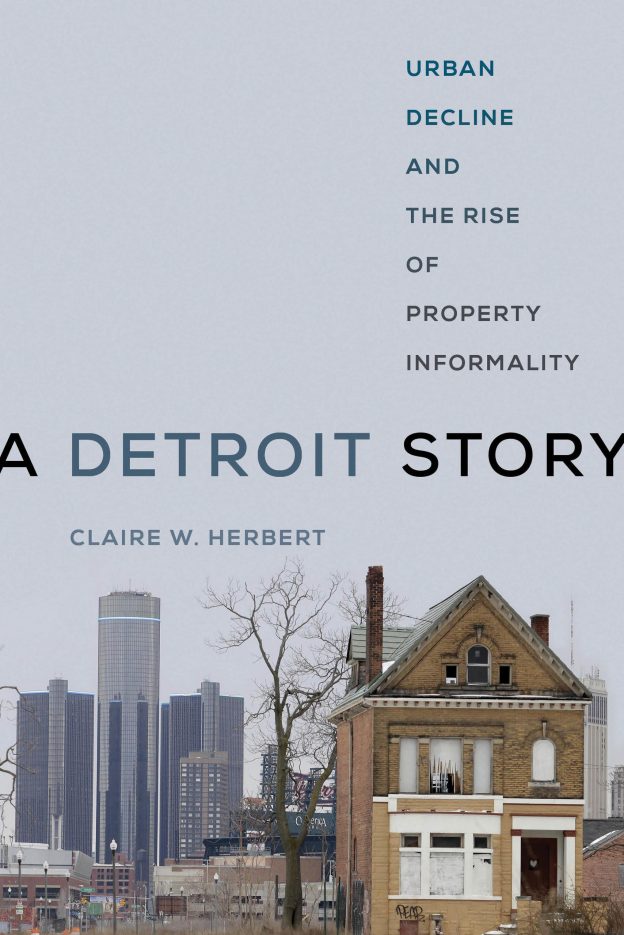Detroit is the United States’ iconic shrinking city. The birthplace of Motown, it once offered good jobs in the auto industry, a place where people could buy a house and make a home. With its current population at about one third the level of the city’s peak, Detroit residents experience population loss in all dimensions of life. Claire Herbert’s excellent book A Detroit Story explores residents’ experiences within the informal property regime that has developed following the departure of so many from the city.
A Detroit Story is divided into three sections. Part I ‘Social and Spatial Context’ reframes the dominant narrative of property abandonment as one of property informality. In chapter 1 ‘Urban Decline and Informality’, Herbert locates the research within the literature on informality and urban population loss. Chapter 2 ‘Regulations and Enforcement’ contextualizes the situation in Detroit to show how enforcing regulations became virtually impossible. In Chapter 3 ‘From Illicit to Informal’, Herbert focuses on property informality, and how actions that are technically illegal gained social legitimacy as people navigated living in a city with unoccupied buildings and an under-resourced local state. This framework, while commonly used to explain urban processes in the global South, is less widely used in the global North despite widespread informal housing and work. Herbert uses informality as a concept that helps show how and why people are living as they do, and suggests that more attention to informal urban practices and research could lead to better policy and planning decisions in America’s shrinking cities, including Detroit.
Part II ‘Informality in Everyday Life’ offers a rich and insightful narrative that explains how residents experience living in Detroit, and how they understand a property regime where they and others appropriate, steward and deconstruct abandoned buildings and vacant lots. Herbert proposes a typology of people who are engaged in informal property practices. Chapter 4 introduces the typology, with the subsequent chapters dedicated to each of three categories thus defined: Necessity Appropriators, Lifestyle Appropriators and Routine Appropriators.
In chapter 5 ‘Necessity Appropriators’, Herbert explores the experiences of predominantly Black and low-income residents who squat and scrap for their shelter and livelihoods, showing their creativity within the constrained options. The predominantly White Lifestyle Appropriators, the subject of chapter 6, have more resources than the Necessity Appropriators, and choose to squat before acquiring property through formal processes based on the desire for an alternative lifestyle. Chapter 7 discusses the experiences of ‘Routine Appropriators’, oftentimes Black homeowners who appropriate property and scavenge to improve their neighborhoods and situations, given the often harsh realities which accompany living in neighborhoods with such significant population loss and a city with such diminished capacity to maintain neighborhood quality. Chapters 5 through 7 are comprised of numerous vignettes to explain different people’s situations, their forms of living, and their thoughts on the situation in Detroit. The vivid details along with the residents’ reflective perspectives create a compelling account of daily life; a focus that has received too little research attention to date.
Part III titled ‘Informal Plans and Formal Policies’ develops two themes based on the divergent experiences and perspectives from Part II. In chapter 8, Herbert contrasts the different visions for Detroit as articulated by the newcomers, who see themselves as urban explorers looking for alternative forms of living, and longtime residents, who were getting by in a failed city. These divergent perspectives, alongside grounding the urban exploration in the history of the urban frontier, provide a welcome change from the celebratory accounts of DIY urbanism that fail to acknowledge the relative privilege of different actors.
This theme is taken further in chapter 9 ‘Regulating Informality, Reproducing Inequality’, which examines policies adopted by the City to encourage some of the appropriators’ activities—but in ways that make it easier for the Lifestyle Appropriators while creating additional hardship for others. In the Conclusion, Herbert reflects on the need to learn from informality so as to avoid interventions that will worsen the situation for many residents.
A Detroit Story is an original and engaging book on a well-researched city. The vivid account shows how people live in and navigate a city where conditions are worsening and where the formal institutions of collective life have failed (including, but not limited to the institution of property), as well as the new systems that have replaced them. It is optimistic at times, as it reframes the familiar tale of decline into one of changing institutions, yet it ends with the reality that people are struggling and, if given the choice, the majority of people would prefer to have safe affordable housing and well-maintained communities.
A Detroit Story provides an invaluable contribution to urban studies research and is relevant for researchers in myriad disciplines as well as upper division undergraduate and graduate students. Anyone with an interest in Detroit and shrinking cities, as well as planners and policymakers who work in these contexts, will also appreciate the assessment of how—albeit unintentionally—planning and policy can and will reproduce inequality if they fail to recognize how people live and why.
Renia Ehrenfeucht is a Professor of the Community and Regional Planning Department and the Associate Dean for Research at the University of New Mexico School of Architecture and Planning.
Claire W. Herbert. A Detroit Story: Urban Decline and the Rise of Property Informality. Oakland, CA: University of California Press. © 2021. Cover used with permission of University of California Press.
Views expressed in this section are independent and do not represent the opinion of the editors.

